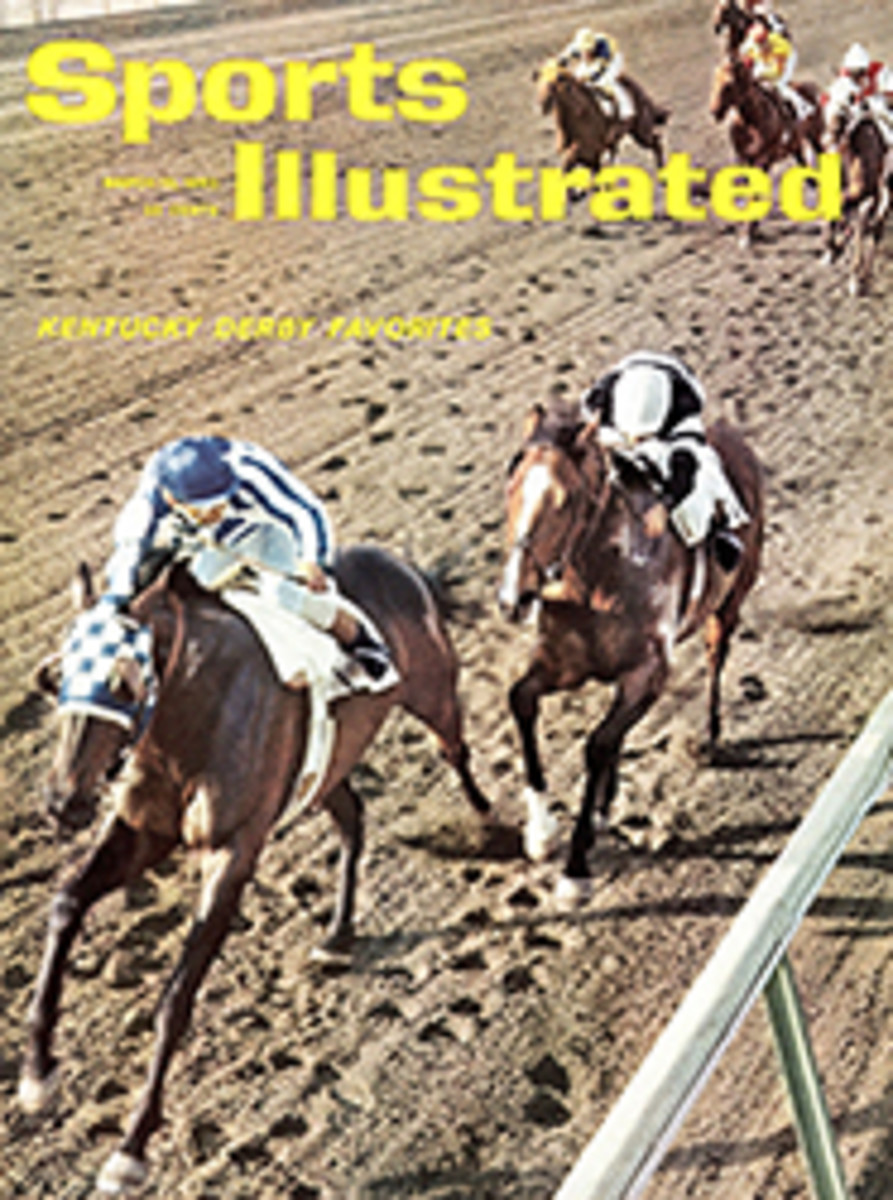
The knee is not for bending
Of all the manifold exercises that bedevil the athlete on his way to glory, the Deep Knee Bend and its wicked descendant, the Duck Waddle, are the most unloved. The Deep Knee Bend is a hand-me-down from basic fitness formulae and is self-defining. The Duck Waddle, a favorite for torturing football players, is executed from a fixed squatting position and is so called for its resemblance to the walk of a duck that has just been hit behind the ear. The Army improved the Duck Waddle with a conjunctional horror of its own known as the Squat Jump, or Death Bounce, which is an alternating knee bend performed in spastic jerks and calculated to leave the legs with just enough juice to move the body to a couch.
The best possible thing one can now say for these three exercises is that they are rapidly going out of business. They have lost face. Studies show them to be of little conditioning value. Worse, they are adjudged harmful by many informed persons—an opinion welcomed by athletes, who have always thought them nasty. The incidence of knee injury in ratio to deep knee exercises has, when pointed out, genuinely alarmed the nation's football coaches. Many now claim to have struck these exercises from their regimens long ago.
The unacknowledged leader of the abolitionist movement and the provider of most of the damning statistics is an associate professor at the University of Texas who has studied the knee for 20 years. Professor Karl K. Klein, in fact, is on such familiar terms with it that he speaks of cartilage and ligament as if they were sons and daughters, and even keeps a piece of the gristly, milk-white cartilage from his own knee in ajar of alcohol on his desk. His charts and statistics are voluminous. He has lectured and written unceasingly on the knee. He has invented a calibrated instrument to measure its pitch and yaw, and apparatus to strengthen it. His friends say it would not-surprise them if he some day ossified into a kneecap himself. When Texas football players limp off the field, people have been heard to cry: "There goes another statistic for Klein!"
AMA disapproves
It was, thus, a delight to Klein in July of 1961 when the Army ordered an end to two decades of squat jumping, though his joy was short-lived—the brass promptly substituted a Deep Knee Bend, with rifle. This, in Klein's view, was reverting from fire to pan—"anything below a half knee bend," he says glumly, "is useless and ruinous." A finer endorsement of Klein's position, without strings, came in the August issue of the Journal of the American Medical Association. The AMA "generally disapproved" of deep knee exercises, and spoke darkly of their "potential for severe injury (medial cartilage deterioration) to the internal and supporting structures of the knee joint." And in New York last week the superintendent of schools passed the word to gym teachers: no more exercise involving the deep knee bend.
By most standards, Klein is no Texan. He is a 47-year-old native of Buffalo, and a University of Indiana graduate, who resorts to squash for recreation. On his bony head a cowboy hat (which he wears gamely) is as misplaced as the Greek columns atop Texas' Spanish-rococo Administration Building: it sits gingerly, as if afraid to take hold. Klein himself, however, is a take-hold guy with an inventive mind, a cheery nonstop pitchman for his assortment of ideas, and he thinks big—which is in keeping with the Texas posture. Not long ago he asked for and got a $10,000 government grant to further his study of the knee. "My hobby," he said, "then became my work."
The knee held no particular fascination for Klein until he unhinged one of his own in a high school hockey game. A dozen years later, in 1945, he watched by mirror as Navy doctors extracted the torn cartilage. Afterward he was granted permission to assist at other knee operations—"which pretty much surprised some of the guys in the operating room. Including, I suppose, the patients."
At Texas, Klein heads up a unique Physical Education Rehabilitation Laboratory, into which stream athletes in disrepair and fat liberal arts majors who are dissatisfied with the shape of themselves. Klein gives them equal time. The rehabilitation section is under the Department of Required Physical Education, which dedicates itself to "getting young men in shape to enjoy their weekends."
Klein's laboratory baby is his all-aluminum measuring device that clamps around the thigh and calf, with a calibrated tolerance dial at the joint. He lovingly keeps it under lock in his cubbyhole office in the basement of Gregory Gymnasium. With the instrument, and with a blood pressure bulb to gauge the pressure applied, Klein is able to measure the play in the knee and the tensional strength of the leg. The tighter the ligament, the more fit the knee. "When the knee receives a blow," he explains, "the ligament sends an instantaneous signal to the brain, calling for tighter muscles to take up the slack. The brain immediately returns the signal to the muscles, ordering them to tighten up. But if the ligaments are stretched, as they are by deep knee bends, the entire process is slowed up, the signal is delayed and an injury results."
With the use of his device, Klein can detect ligament looseness in advance and prescribe corrective exercise. At that point another of his contraptions is brought into play: a bench on which the subject sits, bent-legged, with feet down and out and hooked under a crossbar. By tensing upward, with stress on both the hamstrings and quadriceps, the knees straighten and the trunk rises from the bench. The object is to tighten the ligaments and buttress them with strong muscle.
Using his instrument in a study of 54 men and boys who had done deep squats and 172 who had not, Klein found 72% more ligament instability, or weakness, among the squatters. Now he especially watches for imbalance—a condition in which one leg is stronger than the other. In collecting data on 600 players on 23 teams from Maine to Texas during a four-year study, he found that of 64 knee injuries reported, 51 were on the weak or "loose ligament" knee.
There is a strong and wide body of opinion to back up Klein's findings. Georgia Tech Coach Bobby Dodd believes that the knee joint "is just not designed" for football as it is played today. Nothing short of an elaborate brace, he says, will fully protect it. Its vulnerability is further catalogued by an extensive study made by the National Athletic Trainers' Association in 1952. It showed that injuries to the knee were responsible for 31% of the man-hours lost per game, far exceeding the figures for other injuries. The "football knee" keeps star players parading in and out of infirmaries, and on and off operating tables.
By word of mouth, and by virtue of Klein's cascade of literature, the indictment of deep knee exercise got around. At UCLA, Trainer Ducky Drake said he had reduced injuries substantially by quitting the duck waddle in favor of a "quarter eagle," or half knee bend. "The deep knee bend bends the knee far more than any athlete ever does," he said. Ohio State gave up both knee bends and duck waddles years ago; so did Wake Forest, Southern Cal, North Carolina State and Georgia Tech. Now hardly anybody admits to doing either, "except in high school." Two colleges that stuck with the knee bend were Auburn and Georgia—and both reported the incidence of knee injuries to be "definitely up." At Georgia there have been three operations since Christmas to correct knee damage suffered last fall.
Duke University, for some reason, seems out of step with the rest of its southern brothers: Duke has used neither duck waddle nor knee bend for 10 years—but came up to the final game of its 1960 season with eight regulars inoperative due to knee injuries. Georgia Tech's Dodd has an explanation, however: "It's the age we live in," he says. "Boys grow up with weaker knees because they don't walk. Everybody rides."
Darrell Royal, head coach at Texas, when an assistant at Oklahoma, heard Dr. Donald H. O'Donoghue, a team physician, say that "deep squats pinch the cartilage forward, like an apple seed between your finger and thumb." And since becoming head coach, Royal will brook neither squats nor duck waddles. Texas Trainer Frank Medina therefore reverts to some of Dodd's fundamentalism: he drives weaker-legged Longhorns 30 miles out to Georgetown, drops them from his car like unwanted kittens, and has them walk back to the campus.
Go pigeon-toed
Royal sends his post-injury problems to Klein. H. G. Anderson, a guard on Texas' 1960 team, was able to go 10 full games without a mishap (and with loose ligaments) by using, Klein said, a personalized technique. "He was taught to keep tension on his muscles, to run and cut on the ball of his foot. He compensated." Klein would have all athletes run pigeon-toed. "Most great ones, like, say, Jackie Robinson, have feet that either tend to turn inward slightly or at least point straight, putting everything in better mechanical position for safety and power." To achieve this, he has suggested a strategic taping of the knee to force a pigeon-toed gait.
Klein has found, too, that the man who looks loose-jointed may not be at all. Johnny Saxton, Texas' All-America halfback, is such a one. "Everybody talks about how he runs like a water bug, all skittering and loose-legged," Klein says, "and he does—but I'll tell you this: he has tight ligaments." Saxton had no knee problems, and the Texas team had relatively few, but its followers are willing to concede that the Longhorns would have whupped TCU (the only loss in '61) had Fullback Ray Poage not been out with an injured knee.
Klein's correspondence spans the globe. Dr. Melvin A. Casberg, head of the Christian Medical College in Punjab, India, made this response to Klein's theory that squatting—as done by Indian fakirs—contributes to arthritis: "[I find that] by the fourth decade of life, an extremely large portion of the population here is affected [by osteoarthritis]." A Japanese doctor suggested a relationship between squatting and the short legs of his people. Dr. Barnard Kleiger of New York stated that the "deep plié" executed by professional dancers results in derangement of the knee joints. The deep squat does the same to the weight lifter, Klein feels, but, as in ballet and in baseball, where the catcher is doomed to a life of squatting, it is part of the routine and it must be considered "an occupational hazard."
There is no sign of a letup in Klein's programming and data-finding. With Dr. William L. Hall, the Texas team physician, as co-author, he will soon publish a book, The Knee in Athletics. His inventions, he says, "are for anybody who needs help or has an interest," and not for personal gain. His statistics and studies are open to fresh territory—e.g., he recently ran a test on six twisters from New York's Peppermint Lounge who were entertaining on the Texas campus. He found their legs were strong, and the ligaments "surprisingly snug." They were in good shape. Three of the twisters were girls, the first Klein had ever tested. "I decided," he said, "that here was an area worth investigating."
Let unfit twisters, however, beware: what they are really doing is a type of duck waddle on half-bent knee. By way of warning, Klein offers a clipping from the school paper, a picture story about Liz Towels, a pretty Texas coed and a gifted twister. The caption under the picture of Liz with her knee in a cast said she would not be twisting again for several weeks.
TWO ILLUSTRATIONS

